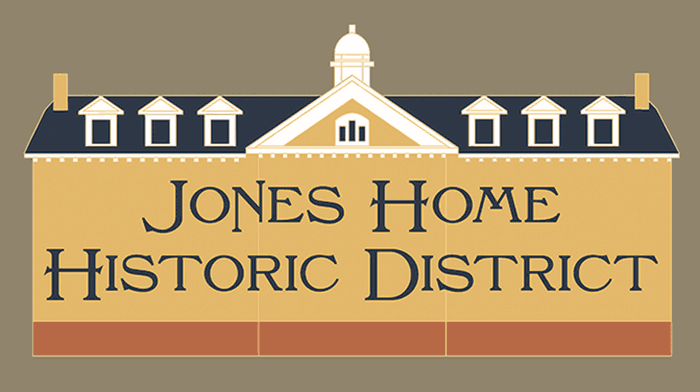The properties within this City of Cleveland neighborhood are a microcosm of well-preserved examples of American architectural styles during its period of significance, from 1872, when the area was first subdivided, through World War I, when the area was completely developed. The neighborhood is focused around four streets: Woodbridge, Marvin, Daisy and Library Avenues. The significance of this neighborhood lies in its overall ambience and its relationship to the Jones Home for Children, a major architectural landmark on Cleveland's west side as its centerpiece. The district is significant for its distinctive street pattern of relatively wide streets, spacious lots and rear lot line alleys that combined with the Jones Home for Children and its spacious park-like setting to stimulate the development of a turn of the century middle class neighborhood that survives largely intact today. Most of the houses in the district are Colonial Revival in style with Queen Anne and other styles interspersed throughout.
The district was influenced by the streetcar, as the streets were laid out east-west for better access to the streetcar lines along Pearl and Fulton Roads. The streetcars also enabled industrial activity to be located further from the residential community, unlike neighborhoods to the north where factories were often built within walking distance of residences.
The area was originally part of the Western Reserve, surveyed by the Connecticut Land Company into part of what became Brooklyn Township in 1818. The earliest settlers of the area were the Brainard and Fish families, who settled here in 1812. The lands were developed early in the nineteenth century into farmsteads, with a row of farms facing onto both sides of what is now West 25th Street. David Jones arrived in Ohio in 1831 from New Jersey with his wife Cynthia and family, including son Carlos Lloyd Jones. By 1867 Carlos had acquired land from the Brainard family and developed a farm on this site. That same year, as Cleveland extended to just south of Clark Avenue, Brooklyn Village was incorporated, with the Jones Farm sitting on its northern end. In 1872 a plat was entered for the northern portion of the former Jones farm that marked the initial development of the district into a residential community. By 1874 the farmstead was subdivided in a series of plats that all followed the same plan as the original allotment, with fairly broad streets and spacious lots with alleys in the rear.
The process for nomination of the district started in 1994 when the former Clark-Metro Community Development Corporation hired Steve McQuillin, of Steve McQuillin & Associates, to identify potential National Register Historic Districts within its service area. Of three potential districts the consultant identified, the Jones Home Subdivisions Historic District gained the most favor. Others involved in the process included former Councilwoman Helen K. Smith and Cleveland Landmarks Commissioner Robert Keiser.
In 2008 neighborhood resident Bob Gardin began work with Mr. McQuillin to update the application, and in 2011 Councilman Brian Cummins directed the new Stockyards, Clark-Fulton, Brooklyn Centre Community Development Office to put the finishing touches on the document for final submittal. The updated application was approved by the Ohio Historic Preservation Office and forwarded to the National Park Service for nomination in February of 2012.
Soon after, the Jones Home Historic District Association began meeting to form a strategy for preservation, enhancement and marketing of the district. In March of 2013, the former Daisy Avenue Area Block Club changed its name to the Jones Home Neighborhood Association (JHNA) and the Historic District Association became a committee of the Neighborhood Association.
The resident driven Committee proposed three District signage projects: development of a State Historic Marker recognizing the Jones Home for Children and the Historic District, gateway signage entering the district, and District logos at each street intersection. The Historic District Committee teamed on content and design details with logo designers, an historian, the Stockyards, Clark Fulton, & Brooklyn Centre (SCFBC) Community Development Office (now Metro West Collaborative Development) and then Councilman Brian Cummins. The signage designs have been finalized and shared with the community through the JHNA. A funding strategy has been secured for the projects and installations are anticipated in 2019.
More to come...
We invite you come along as this website grows. If you share our interest in preserving and sharing the past, we encourage you to join us in our endeavors.
The Jones Home Historic District Committee meets as needed, while the Jones Home Neighborhood Association meets the last Wednesday of each month at 6:30pm in the Jones Home building. For more information about the Association, contact chair Joan Komic at joankomic@yahoo.com. For more information about the Jones Home Historic District, contact committee co-chairs Bob Gardin at bgardin@sbcglobal.net or Alan Forman at woodjockey@juno.com.
National Register of Historic Places
Jones Home Subdivisions Historic District
Woodbridge, Marvin, Daisy, & Library Aves., & W. 25th St., Cleveland, Cuyahoga County, Ohio
Reference Number 12000031
Listed 2/17/12; announced February 24 2012
National Archives Catalog entry: Ohio SP Jones Home Subdivisions Historic District
The Encyclopedia of Cleveland History > Jones Home of Children's Services
Cleveland Public Library Digital Gallery: Jones Home photo 1937
